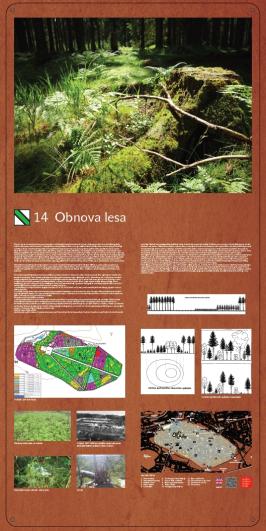(![]() Obnova lesa - informace v českém jazyce)
Obnova lesa - informace v českém jazyce)
The renewal of original forests occurred in a natural way, when young growth appeared under the fallen tree trunks, usually from sprout shoots from stumps, roots, or seeds of surrounding trees. If a man needed wood from the forest, he first got it mostly via the so-called selective cutting, in which he selected types and dimensions of trees he currently needed. As time went by and the need for wood increased, the pressure on the forests kept increasing from the 12th century on, regarding the consumption of wood for building, heating or making charcoal necessary for metal production. In the mid-18th century, the consumption of wood grew to such extent that most forests were basically devastated. Wood was a strategic material, as there was no other source of “energy” apart from water and wind. This inspired Empress Maria Theresa to issue the first “forest laws”, the so-called forest patents, governing the forest economy. They were issued gradually for the individual countries within the monarchy. The forest patents for Bohemia and separately for Moravia were issued in 1754, yet for Silesia, it was not until 1756. This basically meant that upon mining the woods, the owner also had to provide for its renewal. This gave rise to the development of a new field, which is still called “silviculture” today. There are numerous ways of renewing the forests; we will only mention those that are of significance for us.
Sprout economy was used in the past in our foliate growths. Every 5-60 years, the woods were cut down and the sprouting capacity of woods at younger age was used, either from the stumps, or from the roots. The wood from this growth was of a poorer quality, with bended lower parts, and it was mostly used for heating. Several parts of Hvězda were renewed in this way in the periods following wars, when extensive parts of the game-preserve were cut down.
Clear-cutting economy is characterized by large-scale mining with subsequent artificial renewal by means of planting, most often the spruce or pine monocultures. This way allows for the maximum utilization of mechanization, both in the mining of wood, and in the renewal of the forest, having at the same time low demands on the level of skills of the forest keeper. On the other hand, using this type of economy has been associated with a number of huge calamities ever since the 19th century. Calamities caused by wind, snow, frost, or insect pest (e.g. black arches, bark beetles, sawflies, larch tortrich), occurring in these growths with low resistance cause immense damages in our country (simultaneously with damages caused by emissions). Ignoring the ecological demands of the individual types of wood and general introduction of coniferous trees on large surfaces could not end in any other way.
There were periods (especially at the turn of the 18th and 19th centuries, but partially also in the 20th century) when the effort to plant coniferous trees also affected Hvězda, especially with spruce trees planted more extensively.
Currently, the aim is to gradually remove the non-suitable spruce growths and to replace them with local foliate trees naturally forming the forest; this means oak most of all in this territory. The oak often originates in natural regeneration. This intervention in the forest is called a transformation, and it means a replacement of unfavourable composition of wood with another, closer to nature.
Shelterwood regeneration means that mining is carried out on smaller surfaces or only via thinning down the growth, or eventually it is carried out in narrow clear cuttings from the edges. The aim of this type of economy is to achieve the onset of natural regeneration or the protection of the more sensitive wood (beech, fir) within the favourable environment of a shelter from the parent trees from which the growing trees are gradually released. The resulting forest has a more varied species composition, differentiated by age and space. This forest is more resistant to external influences endangering it, such as the wind, snow, or damages caused by animals, insects, and parasitic fungi. This method is also applied at Hvězda.
Selective economy makes most effective use of both the above-ground and underground space, creating a forest resistant towards the impact of the environment or harmful agents, with positive microclimatic conditions. The selective forest is of uneven age, with thickness and age diversification, generally mixed. The maturity criteria include the health of the trees, not only the age or trunk thickness. The removal of old, mature, and often ill trees makes space for the self-seeding of new woods, creating opportunity for the development of trees that have so far been overshadowed. This requires a high level of knowledge of the forest farmer, a gentle and considerate way of economy. This means of economy also allows for the utilization of a natural renewal of the forest from the seeds of the surrounding trees, usually without the need for planting new seedlings. This economy is most suitable for the species-corresponding forests in the Hvězda Game-Preserve natural monument, and it is also recommended by the maintenance plan.
The local forests are maintained in accordance with the principles of sustainable and natural forest economy. One of the main principles of this approach to forests is the effort not to accommodate nature and forest economy to people’s ideas, but on the contrary, use careful learning and monitoring of the natural processes to be able to utilize the creative powers of nature to a maximum extent, with the aim to gradually reduce human interventions. The Capital City of Prague as an owner of land, not only at Hvězda game-preserve, was awarded a respected, very strict certificate of the Forest Stewardship Council (FSC) in 2007, focusing namely on ecologically responsible forest economy, also within an international context.
Besides mining followed by forest renewal, there is also the so-called improvement mining – improvement cutting. They remove trees which are damaged, suppressed, or dry from the forest, supporting those that are prospective from the point of view of species, health and space. Improvement cuttings are also used to modify the species composition of the forest, removing woods that are not the target, i.e. woods that are not supposed to remain in the growth. The local forest economy includes the fulfilment of the non-production function of the forest, which is of utmost importance here, in the most protected part of nature and in the forest with a special purpose.
Nature trail "Oborou Hvězda":
- The History of the Game-Preserve
- Old Oak Growths
- Hvězda and its Surroundings
- Birds in the Game-Preserve
- The Pleasure House
- Personalities in the History of Hvězda
- Natura 2000 and wetland
- Beech-Wood under the Pleasure House
- Water in the Game-Preserve
- The Geology of Hvězda Game-Preserve
- The Battle of Bílá Hora
- Hvězda Game-Preserve and Hunting
- Animals in the Game-Preserve
- Forest Renewal (Obnova lesa - informace v českém jazyce)





